
The Nymphenburg Palace is a Baroque palace situated in Munich's western district Neuhausen-Nymphenburg, in Bavaria, southern Germany. The Nymphenburg served as the main summer residence for the former rulers of Bavaria of the House of Wittelsbach. Combined with the adjacent Nymphenburg Palace Park it constitutes one of the premier royal palaces of Europe. Its frontal width of 632 m (2,073 ft) even surpasses Versailles.

Schloss Weißenstein is a Schloss or palatial residence in Pommersfelden, Bavaria, southern Germany. It was designed for Lothar Franz von Schönborn, Prince-Bishop of Bamberg and Archbishop of Mainz, to designs by Johann Dientzenhofer and Johann Lukas von Hildebrandt. Weißenstein, built as a private summer residence, remains in the Schönborn family. It is considered a masterwork of Baroque architecture.

Berg Palace is a manor house situated on the east bank of Lake Starnberg in the village of Berg in Upper Bavaria, Germany. The site became widely known as the last residence of King Ludwig II of Bavaria and location of his disputed death. Today, it serves as residence of Franz, Duke of Bavaria, head of the house of Wittelsbach.

The Villa Merian, with its English Garden, stands on the elevated plain above Brüglingen in Münchenstein, in the canton of Basel-Country in Switzerland.

Schloss Nordkirchen is a palace situated in the town of Nordkirchen in the Coesfeld administrative district in the state of North Rhine Westphalia, Germany. The schloss was largely built between 1703 and 1734 and is known as the "Versailles of Westphalia" since it is the largest of the fully or partly moated Wasserschlösser in that region. It was originally one of the residences of the Prince-Bishopric of Münster.

The Electoral Palace in Koblenz, was the residence of the last Archbishop and Elector of Trier, Clemens Wenceslaus of Saxony, who commissioned the building in the late 18th century. In the mid-19th century, the Prussian Crown Prince had his official residence there during his years as military governor of the Rhine Province and the Province of Westphalia. It now houses various offices of the federal government.

Gaussig House is a manor house in Palladian style located in the district Bautzen in the German state of Saxony approximately 6 km southwest from the Upper Lusatian central city Bautzen. Extending over some 75 acres (300,000 m2), nestled in beautiful natural surroundings and bordered by the Grosse Picho hill to the south, lies one of Upper Lusatia’s largest landscape parks. Gaussig House, the orangery, the church and vicarage, and the estate form the centre of Gaussig village.

Boughton Monchelsea Place, previously Boughton Court, is a 16th-century country house in Boughton Monchelsea, Kent, England. The first part of the house was built by Robert Rudston circa 1567–75 on the site of an earlier manor house. It has been modified a number of times during its history achieving its present form in 1819. It has been a home to a number of members of parliament for Maidstone or for Kent, including Sir Francis Barnham, Sir Robert Barnham (1646–85) Sir Barnham Rider (1698–1728) and Thomas Rider (1805–47).
The New Town Hall in Waren was inaugurated in 1862. It is located in the town centre of Waren in Mecklenburg, Germany, on the market square (Marktplatz) near Sain Mary's Church.

St. Mary's Church in Marienberg in the German state of Saxony is an Evangelical-Lutheran church in the southeast of the county of Erzgebirgskreis. It is the most recent of the three Ore Mountain Late Gothic hall churches.
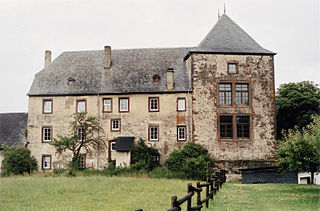
Dudeldorf Castle is the most important monument in the parish of Dudeldorf in the district of Bitburg-Prüm in the German state of Rhineland-Palatinate. The castle is in the northwest corner of the former village walls of Dudeldorf. It was built in 1345 and restored 1451–53.

Ince Blundell Hall is a former country house near the village of Ince Blundell, in the Metropolitan Borough of Sefton, Merseyside, England. It was built between 1720 and 1750 for Robert Blundell, the lord of the manor, and was designed by Henry Sephton, a local mason-architect. Robert's son, Henry, was a collector of paintings and antiquities, and he built impressive structures in the grounds of the hall in which to house them. In the 19th century the estate passed to the Weld family. Thomas Weld Blundell modernised and expanded the house, and built an adjoining chapel. In the 1960s the house and estate were sold again, and have since been run as a nursing home by the Canonesses of St. Augustine of the Mercy of Jesus.

Schloss Hohenburg is a Baroque schloss (palace) in Lenggries, Bavaria, Germany.
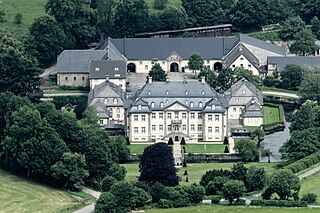
Schloss Körtlinghausen is a Baroque Schloss (château) in Germany's Sauerland region, roughly equidistant between Dortmund and Kassel. It is sited on the southern bank of the River Glenne and it is surrounded by a moat.
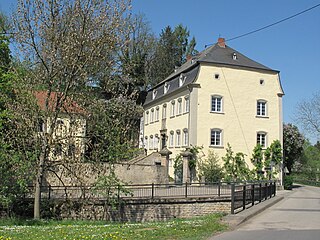
Schloss Holsthum, also called Herrenhaus Laeis, is a manor house in the municipality of Holsthum in the county of Eifelkreis Bitburg-Prüm in the German state of Rhineland-Palatinate. It is a cultural monument and listed building.

All Hallows' School Buildings are a heritage-listed group of Roman Catholic private school buildings at 547 Ann Street, Fortitude Valley, City of Brisbane, Queensland, Australia. They were designed by a number of notable Brisbane architects and were constructed over many years. The earliest is the All Hallows Convent, also known as Adderton. The buildings were added to the Queensland Heritage Register on 21 October 1992.
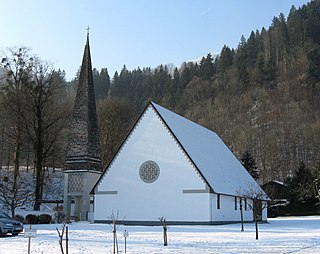
Franz Lichtblau was a German architect.

Alfdorf Manor, called the Oberes Schloss, is a 17th century schloss located in Alfdorf, Germany, and its town hall.

Horst Castle, located in the Horst district of Gelsenkirchen, is recognized as one of Westphalia's oldest and most significant Renaissance buildings. During its construction in the 16th century, it ranked among the largest four-winged castle complexes north of the Alps, significantly influencing the architectural style of the Lippe Renaissance. On December 15, 1983, it was declared a listed building.
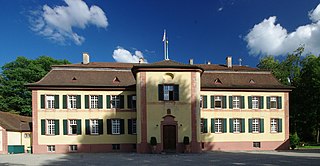
Schloss Ebnet is a baroque mansion in Ebnet, a district of Freiburg im Breisgau.




















